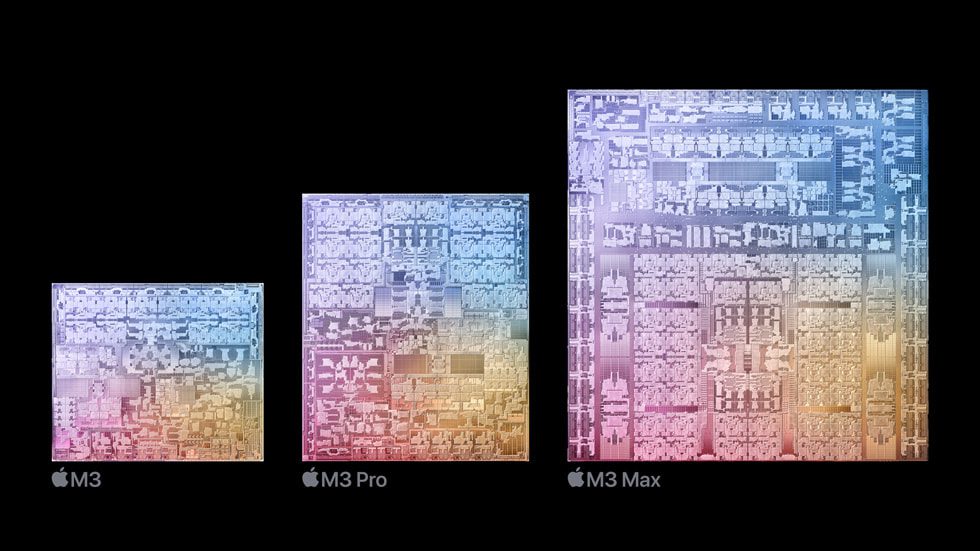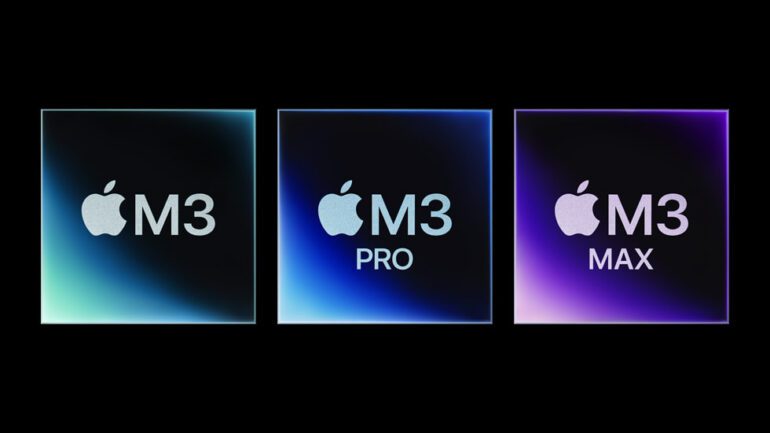TL;DR:
- Apple introduces M3, M3 Pro, and M3 Max chips for Mac, setting new standards.
- These chips feature groundbreaking 3-nanometer technology for enhanced performance and efficiency.
- The M3 series offers a next-gen GPU, 30-50% faster CPU cores, and a 60% faster Neural Engine compared to M1.
- Dynamic Caching, hardware-accelerated ray tracing, and mesh shading enhance graphics capabilities.
- Unified memory architecture with support for up to 128GB boosts efficiency and performance.
- Enhanced Neural Engine accelerates machine learning tasks, while the media engine supports AV1 decoding.
- M3, M3 Pro, and M3 Max cater to different user needs with varying transistors, GPUs, CPUs, and memory.
- Apple’s focus on energy efficiency aligns with its sustainability goals, offering up to 22 hours of battery life.
- These chips redefine the Mac experience, leading to a faster, more efficient, and environmentally responsible future.
Main AI News:
In a groundbreaking move, Apple has unveiled its latest technological marvels – the M3, M3 Pro, and M3 Max chips, setting a new standard for personal computers. These cutting-edge chips are the first in the industry to utilize the remarkable 3-nanometer process technology, enabling the integration of more transistors into a smaller space, thereby enhancing speed and efficiency. The introduction of the M3 series marks a significant leap forward in Apple’s silicon journey, surpassing the already impressive M1 family of chips.
The M3 chip family boasts a next-generation GPU that represents a quantum leap in graphics architecture for Apple silicon. This GPU is not only faster and more efficient but also introduces a revolutionary technology known as Dynamic Caching. This innovation optimizes the use of local memory in real-time, ensuring that only the necessary amount of memory is allocated for each task. As a result, rendering speeds are now up to 2.5 times faster than those achieved with the M1 family of chips. Moreover, the CPU performance cores and efficiency cores have seen remarkable enhancements, with improvements of 30 percent and 50 percent, respectively, over the M1, and the Neural Engine is now 60 percent faster than its M1 counterpart. Additionally, the inclusion of support for AV1 decode in the new media engine ensures efficient and high-quality video experiences from streaming services. The M3 family of chips embodies the spirit of innovation that defines Apple’s silicon journey, ushering in massive enhancements and new features for the new MacBook Pro and iMac.
According to Johny Srouji, Apple’s Senior Vice President of Hardware Technologies, “Apple silicon has completely redefined the Mac experience. Every aspect of its architecture is designed for performance and power efficiency. With 3-nanometer technology, a next-generation GPU architecture, a higher-performance CPU, faster Neural Engine, and support for even more unified memory, M3, M3 Pro, and M3 Max are the most advanced chips ever built for a personal computer.”
Dynamic Caching, Mesh Shading, and Hardware-Accelerated Ray Tracing
The next-generation GPU within the M3 chip family represents a monumental leap forward in graphics architecture for Apple silicon. It introduces Dynamic Caching, a groundbreaking feature that optimizes memory usage in real-time, significantly enhancing GPU performance, especially for demanding professional applications and games. With the M3 chips, hardware-accelerated ray tracing is introduced to the Mac, enabling apps to create incredibly realistic and physically accurate images. This, combined with the new graphics architecture, results in pro apps achieving speeds up to 2.5 times faster than with the M1 chips.
Game developers can now harness ray tracing for more precise shadows and reflections, creating immersive gaming environments. Additionally, the new GPU brings hardware-accelerated mesh shading to the Mac, enhancing geometry processing efficiency and enabling more visually complex scenes in games and graphics-intensive apps. Remarkably, all these enhancements come without compromising Apple silicon’s legendary power efficiency, with the M3 GPU delivering equivalent performance to the M1 while using significantly less power and offering up to 65 percent more peak performance.
A CPU that Sets New Standards
The next-generation CPU in M3, M3 Pro, and M3 Max features significant architectural improvements in both performance and efficiency cores. Performance cores are now up to 30 percent faster than those in the M1, making resource-intensive tasks such as coding and audio production in Logic Pro faster and more efficient. Efficiency cores, on the other hand, are up to 50 percent faster than those in the M1, ensuring that everyday tasks are executed swiftly while optimizing battery life. The result is a CPU that delivers the same multithreaded performance as the M1 but with as little as half the power consumption and up to 35 percent more peak performance.
Unmatched Unified Memory Architecture
Every chip in the M3 family boasts a unified memory architecture, a hallmark of Apple silicon. This architecture delivers high bandwidth, low latency, and unparalleled power efficiency. By having a single pool of memory within a custom package, all chip technologies can access the same data without the need for multiple memory pools. This not only enhances performance and efficiency but also reduces the memory requirements for the majority of tasks. Additionally, support for up to 128GB of memory unlocks previously unattainable workflows on a laptop, making it possible for AI developers to work with even larger transformer models with billions of parameters.
Custom Engines for AI and Video
M3, M3 Pro, and M3 Max also feature an enhanced Neural Engine that accelerates powerful machine learning (ML) models. The Neural Engine is up to 60 percent faster than in the M1 family of chips, ensuring faster AI/ML workflows while preserving data privacy. Moreover, AI image processing tools, including noise reduction and super resolution, get a significant speed boost. Scene edit detection in Adobe Premiere and Smart Conform in Final Cut Pro also witnessed a remarkable improvement in performance. Additionally, all three chips in the M3 family include an advanced media engine, providing hardware acceleration for popular video codecs, including H.264, HEVC, ProRes, and ProRes RAW. For the first time, the media engine supports AV1 decoding, enabling power-efficient playback of streaming services and further extending battery life.
Meet the M3 Series: Phenomenal Performance Tailored to Your Needs
- M3: Featuring 25 billion transistors, 10-core GPU, 8-core CPU, and support for up to 24GB of unified memory, the M3 chip delivers unmatched graphics and CPU performance, making it ideal for a wide range of systems.
- M3 Pro: With a staggering 37 billion transistors, an 18-core GPU, support for up to 36GB of unified memory, and a 12-core CPU, the M3 Pro is designed for users who demand even higher graphics performance, making it perfect for graphics-intensive tasks.
- M3 Max: Pushing the boundaries with 92 billion transistors, a 40-core GPU, support for up to 128GB of unified memory, and a 16-core CPU, the M3 Max is tailored for professionals handling the most demanding workloads, especially in video post-production.
A Green Future
The power-efficient performance of M3, M3 Pro, and M3 Max not only delivers exceptional user experiences but also aligns with Apple’s commitment to environmental sustainability. The new MacBook Pro and iMac, powered by these chips, meet Apple’s high standards for energy efficiency and achieve the longest battery life ever in a Mac, with up to 22 hours of usage. Apple is committed to achieving net-zero climate impact across its entire business by 2030, making every chip, from design to manufacturing, carbon neutral.

The M3 family of chips is built using the industry-leading 3-nanometer process technology, and continues the tremendous pace of innovation in Apple silicon. Source: Apple Inc.
Conclusion:
The introduction of Apple’s M3 chip series signifies a significant leap in the personal computing market. These chips, boasting cutting-edge technology and remarkable performance improvements, redefine the user experience on Mac devices. With enhanced graphics capabilities, efficiency, and support for larger memory, they cater to a wide range of user needs. Additionally, Apple’s commitment to sustainability, evident in the chips’ energy efficiency, aligns with the growing market demand for eco-friendly technology. This release solidifies Apple’s position as a leader in the industry and sets new standards for the future of personal computing.

